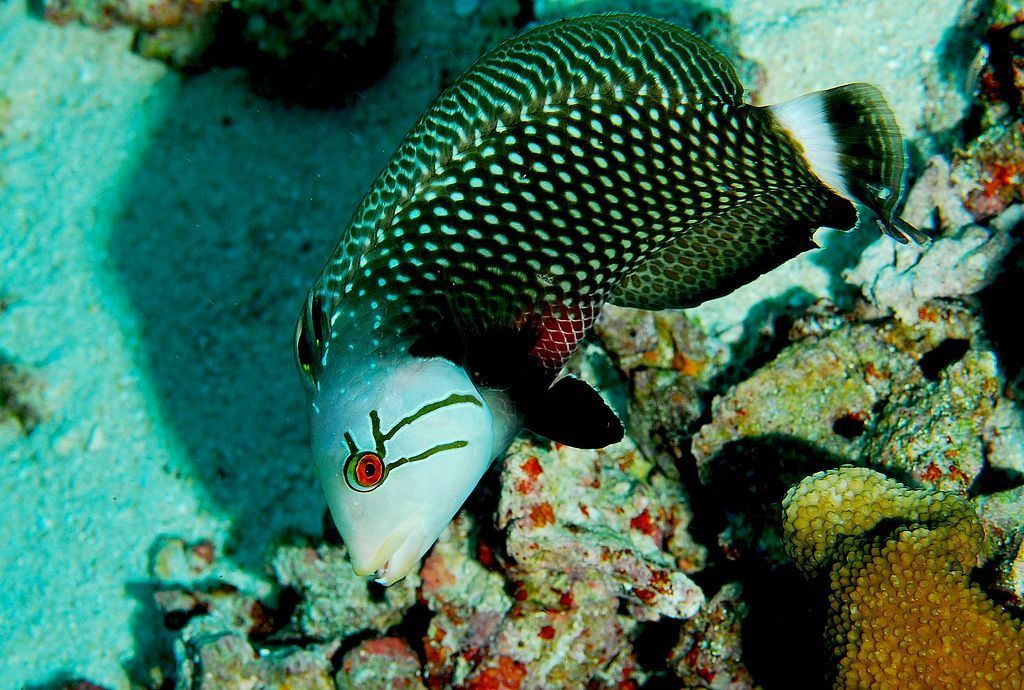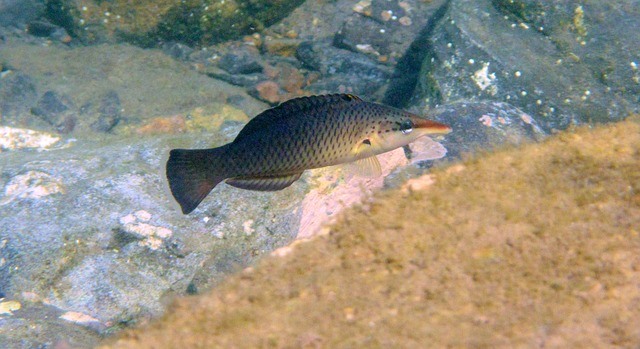When starting your saltwater tank, there are a lot of different fish to choose from. What is a wrasse, though?
The Wrasse is of the family Labridae, and has over 500 species of fish!
Found throughout the tropical waters of the world, they range in size from a few inches, up to the massive Napoleon wrasse (also called the Humphead wrasse), which can grow over six feet long and weigh over 400 lbs.
They vary greatly in color and patterns, and with a little bit of work, these flashy fish make great additions to your saltwater aquarium.
Many wrasse species like burrowing in the sand, and they generally make for great additions to your reef tank.
Since there is such a variety inofhe species, and their needs change based on this, let’s take a closer look at individual requirements for your home aquarium system.
Contents
Types of Wrasse and Their Needs
Six Line Wrasse
The Six Line Wrasse is an active and hardy species, typically growing up to four inches, and they’ve been known to live up to ten years in a tank.
They are pretty disease-resistant as well, and will help keep the rest of your tank clean from pests like flatworms and pyramidellid snails.
They are carnivores, and should be fed at least twice a day a diet of protein formulas and flakes that center on small crustaceans.
They will also eat off of live rock, so be sure the tank has some for them. They are reef safe, as they will not bother the coral or anemones, but may eat smaller crustaceans if they can fit them in their mouth.
This species can be aggressive towards tank mates that are smaller or slower, and should not be kept with other lined wrasses.
Six Line Wrasses are sensitive when first introduced to a new tank, but afterwards are relatively low maintenance.
They should be in an aquarium of at least 30 gallons, with the normal marine fish temperature of 74-79 degrees, and a good amount of either sunlight or moderate artificial light.
They are a diurnal fish, and need a place to hide when it gets dark, preferring small caves within live rock.

Leopard Wrasse
This fish is also called the Blackspotted Wrasse or the Guinea Fowl Wrasse. They typically grow about four inches in length.
This species, like many other kinds of wrasse, are all born female. If there are no males present in a group, the most dominant female will change color and gender.
Leopard wrasses are delicate, and prone to stressing in shipment and tank changes. They are also sometimes fussy when it comes to eating prepared and frozen foods, and may have to be weaned onto these.
When first added to the system, they may disappear into the sandbed for a week or two. This is normal, and even when acclimated they will often bury in the sand to sleep at night – or when frightened.
Once adjusted to the tank, they are a very peaceful community fish, and generally get along well with not only their own species but other species of wrasse without trouble.
Leopard wrasse are perfect for a reef tank, but are a challenge to keep alive and healthy outside of a reef tank.
The aquarium should be at least 50 gallons, and kept within normal marine temperatures and lighting. They need sand to burrow into, at a depth of at least three inches, and this is where they will sleep at night.
Throughout the day, they will forage for food along the live rock, which provides them with the micro-crustaceans they need to eat.
Feed them several times a day, starting with live foods like feeder shrimp and black worms, gradually weaning them onto prepared foods soaked with vitamins, or live food gut-loaded with marine fish vitamins.
This species does have a few health concerns. They do not tolerate copper well, so be careful if you have to treat using copper.
This species is also prone to flukes and intestinal worms, with almost 75% of them arriving with these worms.
Before you introduce them to the tank, make sure you quarantine and treat them for four to six weeks.
Dragon Wrasse
This wrasse species is also called the Rockmover Wrasse or Red-Belly Wrasse, and typically grow up to 11 inches as adults.

They are a pretty easy species to keep, and need a bottom of gravel, along with plenty of rocks and caves to hide in.
They move these small rocks around with their mouth to forage for food, and will hide inside the fine gravel – so ensure you have at last four inches of gravel for them.
These fish need to be fed several times a day, and while they should be started on live food like brine shrimp, they generally move to frozen and prepared foods pretty easily.
As juveniles, dragon wrasse are closer to the color of algae to provide themselves camouflage, but as they mature, they become more colorful.
Dragon wrasse live in pairs as adults, and forage as teams with one fish turning over rocks, while the other eats whatever is found underneath it.
They need a tank of at least 40 gallons and prefer a tank with a lot of light and a decent amount of current. Like other tropical fish, they need a temperature between 74 and 79 degrees.
Cleaner Wrasse
One of the more common of cleaner wrasses is the Blackspot Cleaner Wrasse, also called the Breastspot Cleaner, False Bluestreak Wrasse, Spotbreast Cleanerfish, or Yellow Cleaner Wrasse.
These fish survive by eating parasites off of other fish, and form symbiotic relationships with different species in the wild.
They are a very peaceful and attractive fish, and will often end up forming ‘cleaning stations’ where other fish learn to visit them to get cleaned.
These fish need live rock to hide in and around, and this is usually where they form their cleaning stations.
They need a tank of at least 55 gallons, with the usual marine fish temperature of between 74 and 79 degrees Fahrenheit.
Unfortunately, cleaner wrasses, in general, are extremely hard to keep alive in captivity.
These wrasses survive only on the parasites they clean from other fish, and a healthy reef system in your home simply will not provide them with enough food to survive.

Some of them will accept prepared foods, but will still invariably die due to malnutrition. They typically only live a few weeks to a month in a home system.
If you are looking for a cleaner species in your tank, consider cleaner gobies or cleaner shrimp, which are much hardier and still perform the same tasks.
Melanurus Wrasse
The Melanurus Wrasse is also called the Hoeven’s Wrasse, the Tail-Spot Wrasse, the Yellow-Lined Wrasse, and the Pinstriped Wrasse.
They generally grow to about four inches in length, and are suitable for a reef tank. They are carnivores and should be fed several times a day on a diet including vitamin-enriched proteins and meaty foods and flakes.
The Melanurus wrasse needs a tank of at least 50 gallons, with at least three inches of sand at the bottom. Like a lot of other species, they burrow in this sand at night or when they feel threatened.
They are a generally peaceful wrasse, and are okay to house with their own species, or with other wrasses as long as there is enough food and room.
Christmas Wrasse
The Christmas wrasse, also called the Ornate wrasse, is a native of Hawaii and Fiji, and is named for its red and green pattern.
They grow up to about five inches in length, and are very active and aggressive. They need a tank of at least 50 gallons, with three inches of sand at the bottom for them to hide and forage in.
They also need plenty of rocks and caves to hide in at night. Like other wrasses, they should be fed multiple times a day with a variety of meaty and vitamin-enriched foods.
They are safe for reef tanks, but should be used with caution around shrimp, as they may eat any that are small enough.
Some older Christmas wrasses may begin to nip at corals in search of food, so keep an eye as they get larger in case they need to be removed from your tank.
As these are amongst the most aggressive of wrasses, they should not be kept in a tank with other wrasse species.
Use caution when housing them with smaller or more peaceful fish, as they will bully them out of food, or even eat them if they are small enough.
General Care
Many wrasses can become stressed in shipping and transitioning between tanks, so there are a few things to keep in mind to maintain your fishes’ health and happiness.
When you first introduce your wrasse into the tank, it may hide or bury itself in the sand. Do not try to dig it out, but let the fish come out on its own. This behavior is natural.
These fish are also escape artists. They are strong jumpers, so a hood on the tank is essential. Make sure your hood does not have any gaps, either, as this fish can fit through any hole the size of their head or larger.
In general, wrasses of different species can be kept together. The biggest thing to try and avoid is to have multiple dominant male fish in the same tank, as they will compete for space and food.
Wrasses are known to change their sex, so even if you start with multiple females, a male may eventually emerge from them.
Keep an eye on how your fish interact, and if you end up with an aggressive male, remove him from the tank to restore the peace.
Generally, multiple female wrasses of different species will cohabitate without any issue. If you already have wrasse in the tank, and want to introduce a new one, use an acclimation box.
This will allow the established wrasses to view the new tankmate for two to three days, and if no aggressive behavior is exhibited, they should have no trouble living together.
If the aggressive behavior continues after four or five days, the wrasses may be incompatible. In terms of other fish in the tank, wrasses are generally compatible with most reef fish.
Aim for peaceful or semi-aggressive community fish, but avoid puffers, scorpionfish, lionfish, groupers, or any other fish large enough to eat them.
It’s best to avoid particularly slow fish like seahorses or pipefish, as the wrasses will out-compete them for food.
With a bit of careful selection and care, these funny and colorful fish can soon make a great addition to your reef tank.
Do you own any wrasse fish?



